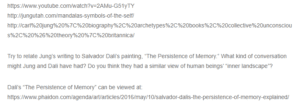Relating Jung’s Writing to Salvador Dali’s Painting
People agree or disagree with a given topic in any conversation. Sharing an opinion or ideology with others is common in conversations or situations. This sharing of ideas and opinions is of great significance because it leads to togetherness and even discoveries in research. Consistently, the works by Carl Gustav Jung and Salvador Dali illustrate shared views. Our assignment writing services will allow you to attend to more important tasks as our experts handle your task. Get in touch with us at eminencepapers.com.
Carl Gustav Jung was a physician whose writings purposed to present a theory on the unconscious (Jacobus 186). Freud had previously positioned that a person’s personality was influenced by the ego, the superego, and the (internal drive) id, which Jung did not agree with, leading to a new theory that introduced archetypes as another constituent of the unconscious. Jung theorized that the unconscious comprises the collective unconscious, personal unconscious archetypes, and ego; in some instances, they are influenced by cultural groups, while in other cases, they are personal experiences (Jacobus 187). From this position, a person’s behavior and personality can be elaborated on and analyzed.
On the other hand, Salvador Dali was a Spanish Surrealist painter. Surrealism was an art movement that replicated concepts of dreams and the unconscious mind in art through art elements in unrecognizable contexts (Janaro and Altshuler 121). In the painting “The Persistence of Memory,” Dali creates recognizable art elements in illogical contexts. The oil on canvas painting constitutes clocks made of flexible and solid material, trees, and a table, among other components. According to Janaro and Altshuler, the watches were used symbolically to represent male sex organs, with the flexible watches representing their feeble state over their happier days in the past (122). The interpretation of this piece of art begs the question of Dali’s personal life and what he was trying to convey.
The kind of conversation Jung and Dali might have had would have involved the unconscious mind. This conclusion is because both their work was based on concepts of the unconscious mind being relayed differently in art and literature. Subsequently, I think they had a similar view of human beings’ “inner landscape” with there being the conscious and unconscious mind.
Works Cited
Jacobus, Lee A. “JUNG: The Personal and the Collective Unconscious.” A World of Ideas: Essential Readings for College Writers, 8th ed., Bedford Books, 2009, pp. 186–198.
Janaro, R. Paul, and Thelma, C. Altshuler. The Art Of Being Human. 11th ed., Pearson, 2017, pp. 121-122.
ORDER A PLAGIARISM-FREE PAPER HERE
We’ll write everything from scratch
Question
http://jungutah.com/mandalas-symbols-of-the-self/
http://carl%20jung%20%7C%20biography%2C%20archetypes%2C%20books%2C%20collective%20unconscious%2C%20%26%20theory%20%7C%20britannica/

Relating Jung’s Writing to Salvador Dali’s Painting
Try to relate Jung’s writing to Salvador Dali’s painting, “The Persistence of Memory.” What kind of conversation might Jung and Dali have had? Do you think they had a similar view of human beings’ “inner landscape”?
Dali’s “The Persistence of Memory” can be viewed at:
https://www.phaidon.com/agenda/art/articles/2016/may/10/salvador-dalis-the-persistence-of-memory-explained/

